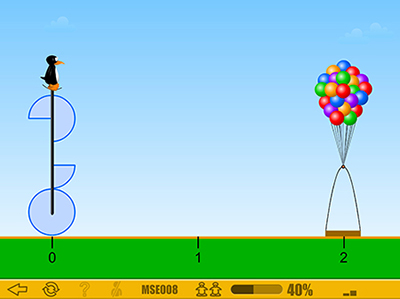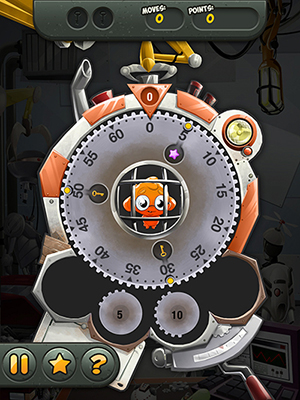Finding the right educational app for your child can challenge even the tech-savviest parent. The more than 4,000 math apps in the iOS store are largely indistinguishable from one another, and many are mediocre in their execution. Which one is finally going to reduce household stress over the multiplication tables or the division of fractions? How can a frazzled parent or discouraged student find it?
First, some good news. As parents, we can stop trying to find the “best” app. The right app is whichever one appeals to the student. Does popping bubbles or racing cars or launching rocket ships excite our young learner? We can safely choose that one. If you need help, companies like Balefire Labs evaluate educational apps against a host of criteria, including whether the app adapts as students learn, whether it is age appropriate, and how easy it is to use.
My son would rather work with an app than a book or flash cards to learn his SAT vocabulary words. My daughter would rather use an app than worksheets for practicing the multiplication tables. Kids pick the tools that work for them. Sometimes that means the fewest bells and whistles, and sometimes it means making a game out of it. Either way, there’s an app for that: Apple’s App Store has some 65,000 educational apps, Google Play more than 80,000, and most of them are free.
Next, some bad news. With very few exceptions, educational apps won’t captivate kids in the way that Angry Birds or Tetris or Plants vs. Zombies will. With casual games, serious games, simulations, or straight-up learning apps, kids engage when the goal of the game feels worthy of their efforts and attention. There is plenty of web ink dedicated to the inadequacies of “chocolate-covered broccoli,” as the field refers to edutainment apps that put a thin veneer of gaming on top of tedious digital versions of worksheets. Kids aren’t fooled.
Despite the best intentions of app developers, we are virtually drowning in chocolate-covered broccoli. There hasn’t yet been full convergence of cognitive science, pedagogy, game design, experience design, and visual design to combine intrinsic motivation and fun in pursuit of digital learning.
Finally, the really good news. Even the simplest of apps can be useful and appealing to kids. Even better, there are a handful of apps, simulations, and games that are cracking the nut of making digital learning intrinsically rewarding. Finally, there are signs on the horizon that even better learning apps are possible and on their way.
Bright Lights in the App World

Courtesy MIND Research Institute
In 2008, when my son was eight and my daughter five, they spent much of their summer vacation watching BrainPOP and programming sprites with Scratch, MIT’s visual programming language for kids. Learning felt like play, and they were hooked. Some 45,000 families have purchased BrainPOP home subscriptions, including 5,000 home schoolers, while the Scratch website receives close to 10 million views per month. The global BrainPOP sites entertain roughly 17 million visitors per month.
The BrainPOP app provides smart, bite-sized animated videos that explore topics in science, engineering, health, and more with just-right levels of explanation. BrainPOP is powerful because it engages kids with real and compelling storytelling that makes it obvious how interesting the world is. It creates unlimited opportunities for serendipity—connecting what a student already knows with something new. But even more powerful is its architectural structure for open exploration.
In the limited school time available, teachers can use BrainPOP as a virtual classroom, asking students to watch a single video and take a quiz. BrainPOP has already been adopted in more than one in five U.S. schools.
A handful of new products hint that finding the Holy Grail is possible—educational games where learning is an inescapable side effect of genuine play.
One such game is ST Math, developed by MIND Research Institute and based on both neuroscience research and professional game development. In ST Math, there are no words, no instructions, and no symbols. Through getting JiJi the penguin from one side of the bridge to the other, students learn such challenging concepts as fractions. This game-based approach to math has been linked to significant improvement on standardized tests in schools, but unfortunately it is not available to families in the home.

Courtesy BrainQuake
BrainQuake’s Wuzzit Trouble is available free from the Apple App Store and has garnered more than 150,000 downloads, despite its lack of advertising. Wuzzit Trouble asks the player to help an imprisoned Wuzzit escape by turning a set of gears in such a way that the bars open and let the poor Wuzzit out. Like ST Math, the game has no instructions and no symbols and doesn’t require a math background. The puzzles are based on integer partitioning. The first few puzzles are easy enough for kindergartners, but eventually they become crazy difficult.
Improved mathematical intuition and algebraic thinking are an inescapable side effect of beating the game. Although there are many ways to win, some elegant and some just brute force, there is no way to win without doing the math in one way or another. The actual game play itself is the math: no broccoli here, chocolate-covered or otherwise.
And while Wuzzit Trouble may not have quite the addictive qualities of Candy Crush, it is well on its way. My kids spent hours and hours trying to beat this game during last year’s summer vacation. Even their grandmother played. Uniquely, it makes that epic-win feeling accessible to everyone as part of math! Pay attention app developers—this is the future of edugaming. From now on, if it takes carrots and sticks to make kids play, it’s game over.
There is much, much more to come. Recent investments in digital games for learning specifically aim to combine core curriculum content with intrinsic motivation. BrainPOP, for example, has invested in a suite of online games (94 so far) that are simple but not patronizing. Guts and Bolts requires systems thinking and problem solving, and, as a side effect, develops an understanding of the role of various fluids inside the body.
Amplify, developers of tablets and digital curricula for education, has developed more than 40 digital games based on core content and then forbidden their use in the classroom or as homework. They are counting on the games to be intrinsically motivating. Social cues and communication options enable students to see what games their peers are playing. This bold experiment will yield tremendous insights into how gaming, peer involvement, core content, and intrinsic motivation can be mixed up into tools for learning that enable students to learn in ways that feel like serious play.
It won’t be too long before the investments of groups like MIND Research Institute, BrainPOP, BrainQuake, Amplify, and others will lead to an explosion of next-generation apps. We will see an ecosystem of high-quality branded developers and independent developers as well. Awards and forums will help us choose the best ones. But until then, we parents and our kids can benefit from the array of serviceable apps available and occasionally—serendipitously—stumble across the brilliant exceptions.
Marie Bjerede is founder of e-Mergents, LLC, which advises schools, start-ups, and technology leaders on enabling and scaling teaching with technology.
For more by Marie Bjerede, please read “Digital Learning via Puzzles, Games, and Simulations”
Education Next is collecting a list of the best educational apps at “Our Favorite Educational Apps“
This article appeared in the Fall 2014 issue of Education Next. Suggested citation format:
Bjerede, M. (2014). Learning in the Digital Age: Better apps are coming. Education Next, 14(4), 86-87.


